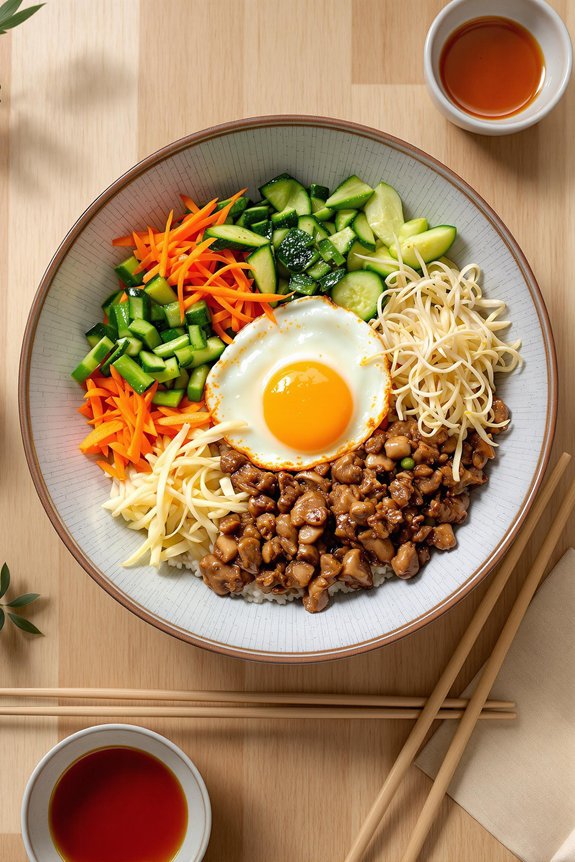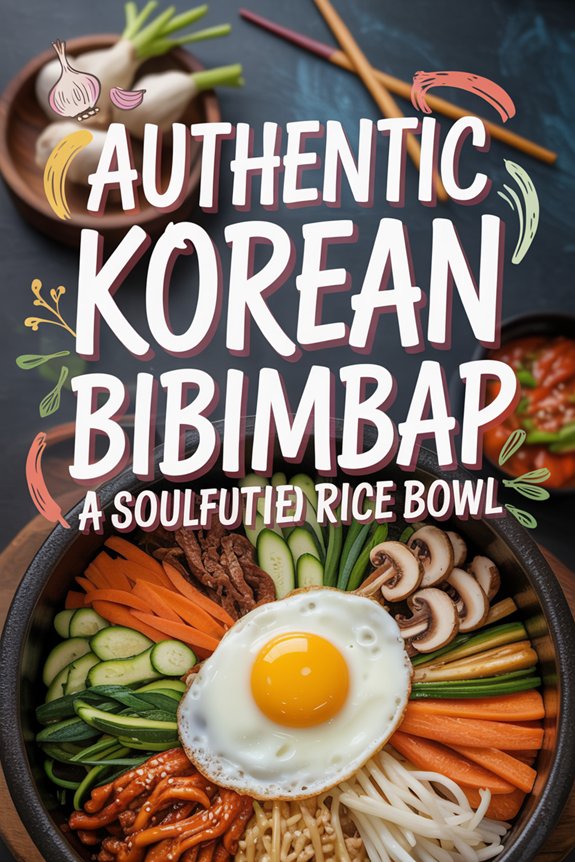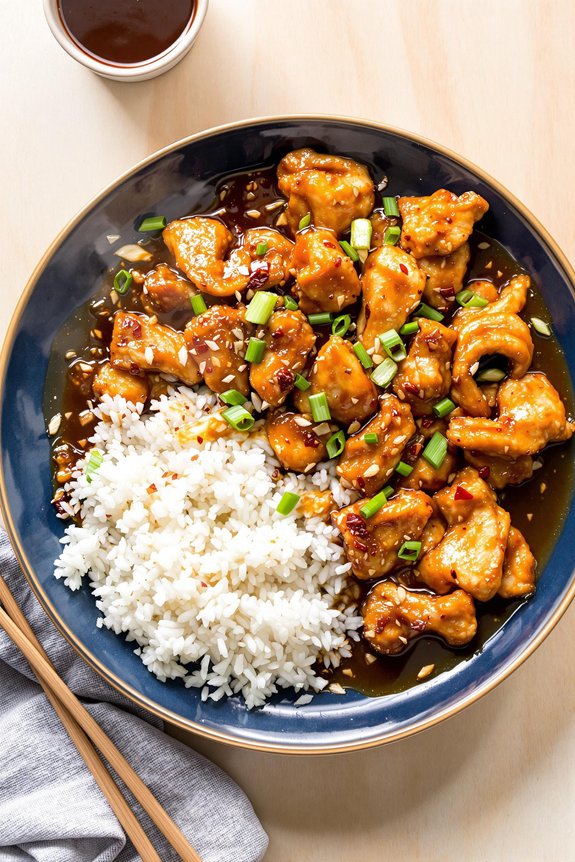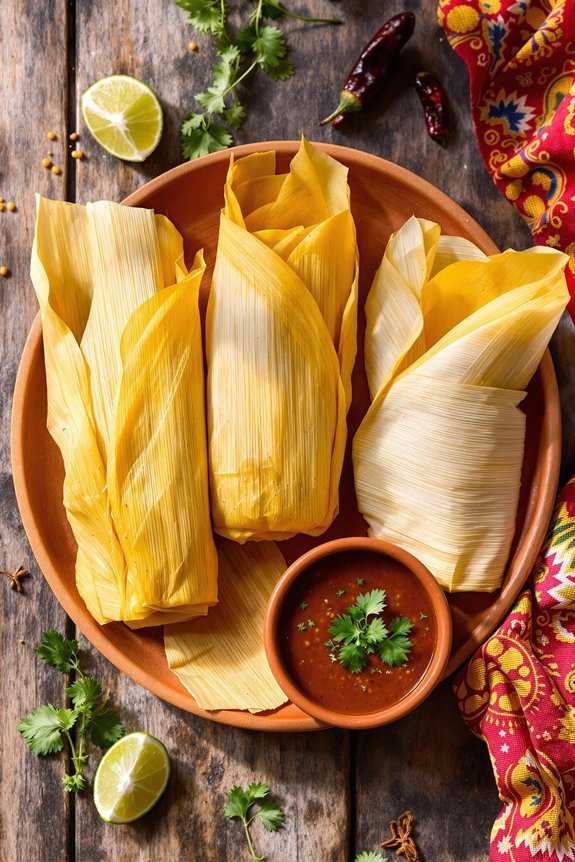Why You’ll Love this Authentic Korean Bibimbap
If you’ve never experienced the colorful delight that’s bibimbap, you’re in for a serious treat. This iconic Korean dish isn’t just a meal—it’s a celebration in a bowl.
What makes it so special? The perfect harmony of textures and flavors, from the crispy vegetables to the runny egg yolk that ties everything together.
I’m obsessed with how customizable bibimbap can be. Don’t like mushrooms? Skip them. Want more heat? Add extra chili paste.
It’s a complete meal that’s surprisingly simple to prepare, despite its impressive appearance. Healthy, satisfying, and visually stunning—what more could you want?
What Ingredients are in Authentic Korean Bibimbap?
The beauty of authentic Korean bibimbap lies in its colorful array of ingredients that create a perfect balance of flavors, textures, and nutrients. Each component plays a crucial role in this beloved dish—from the tender beef with its sweet-savory marinade to the assortment of vegetables that add crunch, color, and nutrition. The name “bibimbap” literally means “mixed rice,” and once you see all these ingredients come together, you’ll understand why this dish has captured hearts worldwide.
- 1 cup short-grain rice
- 1/2 pound lean ground beef
- 2 eggs
- 1/2 zucchini, thinly sliced
- 1 cup mushrooms, thinly sliced
- 1/2 cup bean sprouts
- 1/2 cup carrots, julienned
- 2 tablespoons soy sauce
- 3 tablespoons sesame oil
- 2 teaspoons sugar
- 1 garlic clove, minced
- 1/2 teaspoon grated ginger
- 1/2 cup apple juice
- 1/4 cup Korean chili paste (gochujang)
- 2 tablespoons rice wine vinegar
When shopping for these ingredients, try to find authentic Korean gochujang for that distinctive spicy-sweet flavor that really defines bibimbap. Can’t find it? A good Asian grocery store should carry it, or you might substitute with sriracha mixed with a bit of miso paste in a pinch. The short-grain rice is also important for authentic texture—it’s stickier than long-grain varieties, which helps everything bind together when mixed. And while I’ve listed ground beef here, don’t hesitate to swap it out for thinly sliced beef, tofu, or even just extra vegetables if you prefer a vegetarian version.
How to Make this Authentic Korean Bibimbap
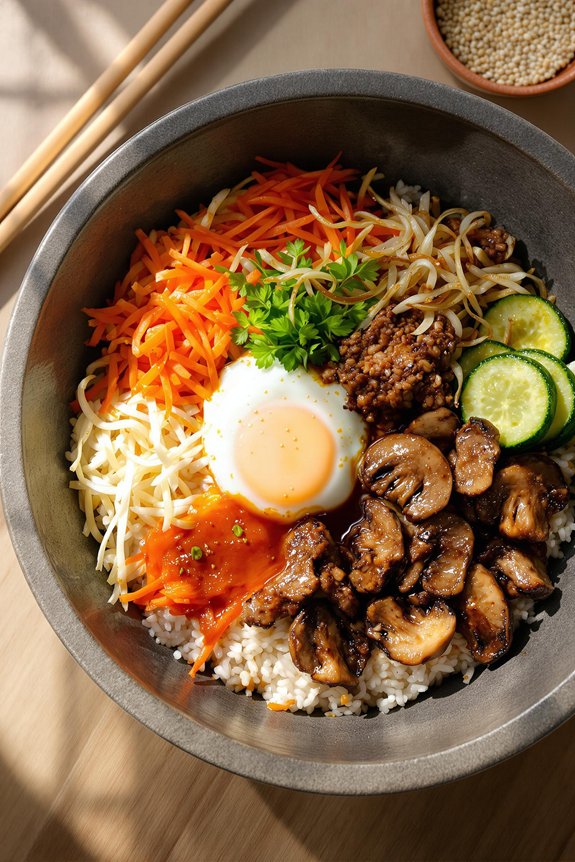
Making bibimbap is all about preparation and layering. Start by creating the marinade for your 1/2 pound of ground beef—in a bowl, combine 2 tablespoons soy sauce, 1 tablespoon sesame oil, 2 teaspoons sugar, 1 minced garlic clove, 1/2 teaspoon grated ginger, and 1/2 cup apple juice. Mix your beef into this flavorful bath and let it sit while you prepare the other components. This marinating time allows the meat to absorb all those wonderful sweet and savory notes.
Next, cook 1 cup of short-grain rice according to package directions—this will form the foundation of your bibimbap. While the rice cooks, prepare your vegetables. Heat 1/2 tablespoon sesame oil in a skillet and sauté your 1/2 zucchini (thinly sliced) until tender, about 5 minutes, then set aside. Use another 1/2 tablespoon oil to cook 1 cup of thinly sliced mushrooms until they release their moisture and become tender.
Quickly blanch 1/2 cup bean sprouts in boiling water for just a minute—they should retain some crunch. Now cook your marinated beef in the same skillet until fully browned. The final touch? Fry 2 eggs in the remaining tablespoon of sesame oil, keeping the yolks runny—they’ll create a silky sauce when broken and mixed with the other ingredients.
For authentic spice flavors, consider using a quality spice grinder to freshly grind any seasonings you add to your bibimbap.
Assembling is where the magic happens. In a large bowl, create a mound with half the rice in the center. Around it, artfully arrange half portions of your zucchini, mushrooms, bean sprouts, and 1/2 cup julienned carrots. Sprinkle half the beef over the vegetables and crown your creation with a fried egg.
Serve with 1/4 cup Korean chili paste (gochujang) and 2 tablespoons rice wine vinegar on the side. When you’re ready to eat, break the golden yolk and stir everything together—watching all those colors and textures combine is almost as satisfying as the first bite. Almost.
Authentic Korean Bibimbap Substitutions and Variations
While traditional bibimbap showcases specific ingredients, numerous delicious variations can accommodate your pantry situation or dietary needs.
Don’t have ground beef? Try tofu, chicken, or even salmon for a seafood twist. Vegetarians can simply omit the meat and double up on veggies.
Speaking of vegetables, the beauty of bibimbap is its flexibility—swap zucchini for cucumber, spinach for bean sprouts, or throw in some kimchi for extra tang.
Can’t find Korean chili paste? Sriracha mixed with a touch of miso works in a pinch.
Rice alternatives like quinoa or cauliflower rice make great low-carb options.
What to Serve with Authentic Korean Bibimbap
Now that you’ve got your bibimbap variations down, let’s talk about what accompanies this gorgeous Korean rice bowl.
Traditional Korean side dishes, or banchan, are the perfect companions. Kimchi is non-negotiable, really—its tangy crunch cuts through the richness of the egg yolk beautifully.
I always recommend some cooling cucumber salad, quick-pickled radishes, or a simple seaweed soup for balance.
A chilled barley tea (boricha) makes the ideal beverage pairing, cleansing the palate between bites.
For dessert? Keep it light with fresh fruit or sweet rice cakes (mochi).
Your taste buds will thank you.
Final Thoughts
After mastering this authentic bibimbap recipe, you’ll understand why it’s considered a cornerstone of Korean cuisine.
The beautiful harmony of flavors, textures, and colors creates a bowl that’s as nourishing as it’s satisfying.
I love how bibimbap allows for endless creativity—swap in seasonal vegetables or protein options that suit your preferences.
The magic happens when that runny egg yolk mixes with the chili paste, coating each morsel with creamy richness.
What I find most special about this dish is how it brings people together.
There’s something deeply communal about everyone mixing their individual bowls at the table.

